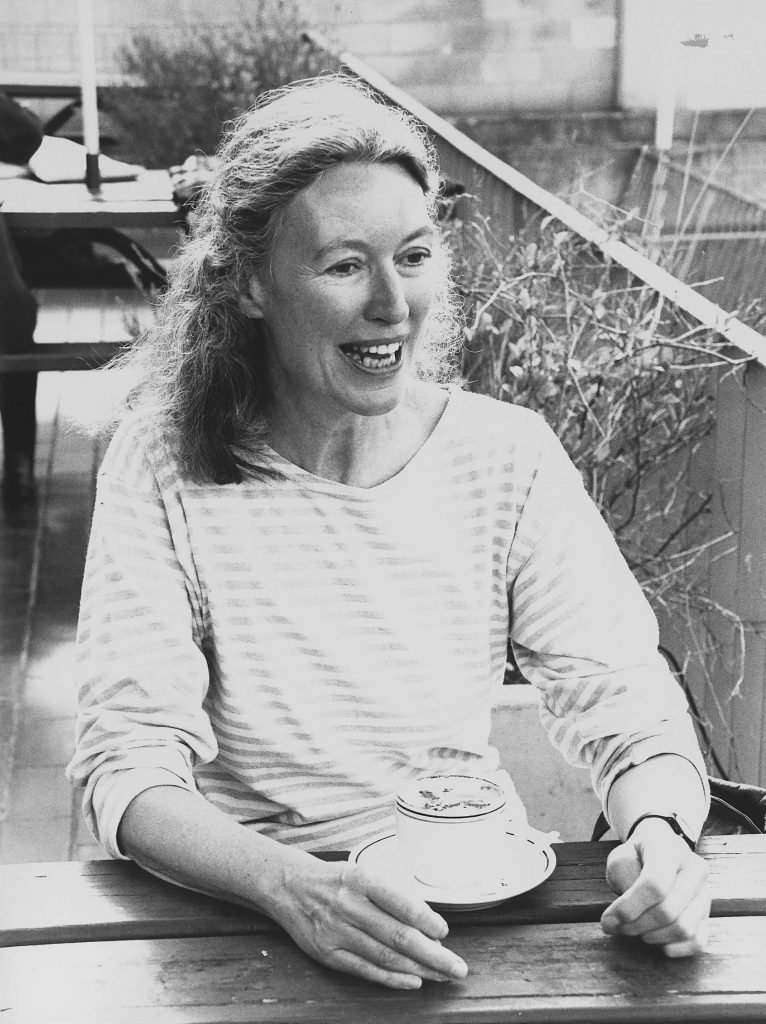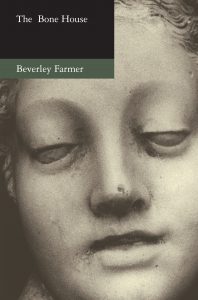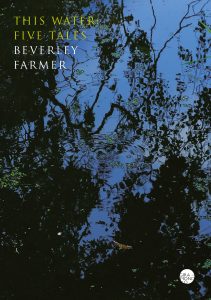In Memoriam Beverley Farmer
A eulogy delivered by Ivor Indyk at Beverley Farmer’s memorial service at Queenscliff on Sunday 29 April 2018.
It is difficult to write a formal eulogy for Beverley Farmer, because she was herself so much a writer of process. Her characters are often portrayed in ‘in-between’ states, in transition – culturally, socially, physically – and she pursues their fluctuating thoughts and emotions with fine discrimination, and a determination to bring to the surface the anxieties, the anger, the impulses to cruelty – and the ecstatic moments too – which lie within those thoughts. There is no aspect of experience she is not prepared to explore, and observe, in the most exacting detail.
It is here, in her commitment to recording the transient moments of experience, that I think Beverley’s most striking achievement as a writer lies. Even in her fiction, it is the dynamic features of the natural world which command her closest attention, in part because her characters cannot be separated from the worlds they inhabit, but also because these elements are sources of wonder or fascination in themselves – the qualities of light and stone, the shifting aspects of the sea, the intricate formations of flower and fruit, the microscopic movements of small creatures – and of impossibly big ones too, like the seal that comes ashore in ‘A Ring of Gold’, the first tale in her last book This Water, ‘humping down the sand, clumsy, laborious’. As you read of its complicated movements, its strange grace and defiance, you immediately draw a comparison with the woman who observes the seal, alone, facing the perils of age, and of Beverley herself, as she would be, defiant in the face of physical and mental infirmity. From the small detail to the large perspective, as in her description of the seal, ‘fluid, fire-whiskered, blind, monumental’, her writing always reaches out, to encompass the world. In A Body of Water, subtitled ‘A Year’s Notebook’, Beverley quotes Francis Ponge, also a master of the detail, on the function of poetry: ‘It is to nourish the spirit of man by giving him the cosmos to suckle.’
It seems natural, therefore, that Beverley should seek a wider, more capacious form for her expanded view of the detail than fiction was able to offer her. She did this first in the writer’s journal A Body of Water, which went beyond the bounds of the short story while at the same time including it; and then, after the novels The Seal Woman and The House in the Light, in the three long essays titled The Bone House, and the works of fable, fairy tale and legend collected in This Water.
I started working with Beverley in 2000, in the preparation of her essay ‘Mouths of Gold’ for publication in the new series of HEAT: a later, expanded version, appeared in The Bone House, published by Giramondo in 2005. During this period we had an intense publisher–author conversation, conducted by email, and largely concerned with securing the multiplicity of connections, associations, quotations, sources and references which underlay this encyclopaedic work. Beverley was renowned for her shyness and almost reclusive nature – but in this relationship, which had the virtue of being both close and distant at the same time, she was completely open about her motives and ambitions, and painstaking in her determination to do justice to the observations, and the multiple links between them, by way of which her work had been composed. She likened her use of sources, being led from one to another on a winding course, to navigating by the elements. ‘I saw what I garnered along the way as gems fished out, that would belong in their chosen setting, and glow, and reflect and be reflected here and there through the text, in a grand pattern. And some I threw back sooner or later, as you do.’ It was an open question as to who was leading whom, in the process of editing. The same attention to detail that characterised her writing, was evident in her attitude to the process of publication. A year after The Bone House was published, she wrote to say that she had found three section breaks which had wrongly been printed as indented paragraphs – a printer’s error, she was kind enough to say, though it was clearly the publisher’s.
While reading her work again, in the aftermath of her death, I felt buffeted, not simply by waves of sadness, but by a kind of despair. To what end, this finely crafted writing, which seeks not only to stop the moment, but to expand its limits, so that it reaches out across time and space? Time had swept the author away. The mind that sought expansion had been cramped by Parkinson’s Disease, subjected to episodes of psychosis and finally to silence. Beverley was as clear-eyed about what was coming as she was about what she sought in her writing. In The Bone House she wrote what I take to be her credo:
Attention to what is. Because whatever is added to the image hoard of one mind is an addition to the world. Not a permanent one, needless to say. What is permanent about a grain of fire in space?
We believe in anything rather than accept that a whole world emblazoned inside the eggshell of the skull is fated for extinction. We must be more than sparks of matter, atoms of infinite being. We bind ourselves to our world in the three dimensions of time with silken threads of soul stuff, threads of light, extrusions of the self into the void, webs of our meaning that we anchor where we may and hang there. The hope of the soul is tenacious. It is inborn, in our bones.
I think, despite her awareness of the presence of death, she was fundamentally optimistic, a primitivist in her way, assured of the relatedness of all things, and therefore of their survival through time. She has this description of the sea, along the coast near Point Lonsdale, where she lived for many years.
A clear day of high surf is scroll on scroll of wave flying in fuming at a long slant from the horizon, translucent, each a deep blue green shell wall of ice. And yet the water is the not moving, not advancing, only the wave is. The pulse, the breath, the soul of water – is it like this, the pulse of being in and through matter, lifting us up through watery coil after coil and dissolving, reforming, rise and fall?
There is a belief in the continuity of experience embodied in her description of its most fleeting aspects, and also, in the power of the written word to express that continuity. In one of her emails she referred to ‘the impulse of the mind to grasp the universe and to abstract and to delve – to give permanent form to this and that fragment of the material world in black and white, in wood, stone, pigments, song, words on paper – the illusory nature of the image once made and the power it holds over us.’ I felt slightly ashamed at my despondency. But I knew, as a publisher, what Beverley didn’t know, how few copies of The Bone House had sold, how difficult it is now, to find readers who want to know her work.
The intense editorial relationship which accompanied The Bone House was repeated only sporadically with This Water, which was published in 2017. There were delays on my part. For Beverley, the symptoms of Parkinsons had set in, and the medication seemed only to be making her situation worse. She was growing increasingly frustrated with her computer: files and emails were failing to transmit or going missing. Things were becoming more and more confused. Fortunately, the five tales had been a long time in the gestation, and had already been thoroughly worked over. Then suddenly this email, in September 2016, a farewell.
Time has run out for me and the stories: tomorrow I go into respite care and then a nursing home. Could you go with what you have, including the June ICE BRIDE, with which I have been fiddling, off and on…
Thank you for your support over the years
Beverley
And after that, silence.
Beverley Farmer is important to Australian literature for many reasons. She was one of the first to carry the cultural elements of the post-war migration into the mainstream of Australian writing, combining Greek and Mediterranean subjects and ways of seeing with the more familiar northern European influences, and those of Asian Buddhism as well. She was one of the leading figures in the renaissance of Australian women’s writing in the 1980s, and one of the boldest. This was at a time when short story collections by women writers were the first thing you saw when you entered a bookshop, and her books Milk and Home Time were chief amongst them. We are used to thinking of the encyclopaedic reach, from the detail to the horizons it envisions, as a masculine aspiration (in Les Murray, Murray Bail or Gerald Murnane for example) – but in works like A Body of Water, The Bone House and This Water, Beverley Farmer claimed this aspiration for women writers, and demonstrated her mastery of it. To my mind it is her bending and opening up of literary form to accommodate this large vision – which she saw as the ‘whole symbolic world in every one of us, teeming with images, dreams, reflections, speculations, memories’ – that is her great contribution to Australian literature.
Ivor Indyk
1 May 2018



